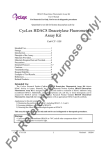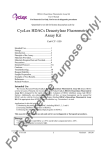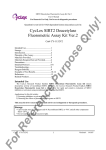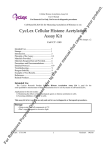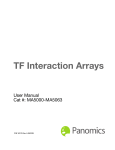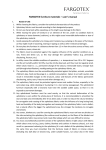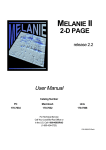Download CY-1158V2
Transcript
Quantitative test kit for histone deacetylase activity
On
ly!
HDAC8 Deacetylase Fluorometric Assay Kit Ver.2
User’s Manual
For Research Use Only, Not for use in diagnostic procedures
CycLex HDAC8 Deacetylase
Fluorometric Assay Kit Ver.2
100 Assays
Pu
rp
Intended Use................................................1
Storage.........................................................1
Introduction..................................................2
Principle of the Assay..................................3
Materials Provided.......................................3
Materials Required but not Provided...........4
Precautions...................................................4
Detailed Protocol.........................................5-7
Cautions.......................................................8
Troubleshooting...........................................8
Reagent Stability..........................................8
Example of Test Results..............................9-10
References....................................................11
Related Products..........................................12
os
e
Cat# CY-1158V2
Intended Use
en
ce
The CycLex Research Product CycLex HDAC8 Deacetylase Fluorometric Assay Kit detects
HDAC activity in lysates. Primarily, the CycLex Research Product CycLex HDAC8 Deacetylase
Fluorometric Assay Kit is designed for the rapid and sensitive evaluation of HDAC inhibitors using
recombinant HDAC8. Additionally, any cultured primary cell, cell line, or tissue homogenate can be
assayed for HDAC8 activity with the CycLex Research Product CycLex HDAC8 Deacetylase
Fluorometric Assay Kit after immunoprecipitation with an appropriate HDAC8 specific antibody.
er
Applications for this kit include:
1) Monitoring the purification of HDACs including HDAC1, 2, 3 and 8.
2) Screening inhibitors or activators of HDAC8.
3) Detecting the effects of pharmacological agents on HDAC8.
This assay kit is for research use only and not for use in diagnostic or therapeutic procedures.
ef
Storage
rR
• Upon receipt store #5. Developer and #6. Recombinant HDAC8 at -70°C and all other components
below -20°C.
• Do not expose reagents to excessive light.
Fo
Cat#: CY-1158V2
1
Version#: 141107
On
ly!
HDAC8 Deacetylase Fluorometric Assay Kit Ver.2
User’s Manual
For Research Use Only, Not for use in diagnostic procedures
Introduction
rR
ef
er
en
ce
Pu
rp
os
e
HDAC proteins are vital regulators of fundamental cellular events, including cell cycle progression,
differentiation, and tumorigenesis (1, 2). A small-molecule inhibitor of HDAC, trichostatin A (TSA),
arrests mammalian cells in both G1 and G2 (3, 4), while overexpression of HDAC1 in mouse cells
reduces their growth rate by lengthening the duration of G2 and M (5). TSA induces terminal
differentiation of mouse erythroleukemia cells and apoptosis of lymphoid and colorectal cancer cells. In
addition, TSA treatment of cells expressing the PML zinc finger protein derepresses transcription and
allows cells to differentiate normally (6). With this precedent, HDAC inhibitors are being actively
explored as potential agents for the treatment of certain forms of cancer (7-9).
The human HDACs are organized into three different classes based on their similarity to yeast HDAC
proteins (1, 2). Class I enzymes are ubiquitously expressed and include HDAC1, -2, -3, and -8, which
are homologous to the yeast RPD3 protein. Class II includes HDAC4, -5, -6, -7, -9, and -10, which are
similar to yeast HDA1 and are expressed in a tissue-specific manner. The Sir2-like class III HDACs,
including SIRT1 to -7, require NAD(+) for enzymatic activity.
It has been reported that HDAC8 is important for the growth of human tumor cell lines and has a
distinct inhibition pattern that differs from that of HDAC1 and -3, which both share 43% sequence
identity with HDAC8. These findings lead to open the way to the development of selective inhibitors of
this subtype as potential novel anticancer therapeutics.
However, the conventional method for measuring HDAC activity is very complicated and laborious.
In order to measure HDAC enzyme activity, it is necessary to prepare radioactive acetylated histone as a
substrate. First, cells have to be labeled metabolically with radioactivity by adding radioactive acetic
acid to the culture medium. Second, radioactive acetylated histone has to be purified from the cells.
Following the reaction, it is necessary to extract and separate the radioactive acetyl group, which has
been released from acetylated histone, using ethyl acetate to measure the activity of the enzyme based on
the radioactivity.
Although a method for measuring the activity of deacetylase without the use of radioactive substances
was reported in recent years, owing to the use of fluorescent-labeled acetylated lysine as a substrate, the
reaction product must be separated from the intact substrate and the fluorescent intensity measured by
reverse phase HPLC. As mentioned above, these measurement systems are difficult to adapt for
processing many samples under a variety of conditions, because of their complicated operation. Thus a
simple system for biochemical analysis as well as for inhibitor screening without the use of radioactive
substances is preferred.
Fo
Cat#: CY-1158V2
2
Version#: 141107
On
ly!
HDAC8 Deacetylase Fluorometric Assay Kit Ver.2
User’s Manual
For Research Use Only, Not for use in diagnostic procedures
Principle of the Assay
os
e
CycLex HDAC8 Deacetylase Fluorometric Assay Kit measures the activity of HDAC by the basic
principle of changing an HDAC reaction into the activity of protease/peptidase. Since it is very simple to
measure common protease/peptidase activity and it can be performed at a low price, the measurement of
HDAC activity in most laboratories is possible if they are equipped with a fluorescent reader for
microtiter plates. Considering that the use of fully automatic apparatus to measure fluorescence intensity
has become widespread, HDAC activity measurement, which could not be made by the conventional
method, is now possible with the CycLex HDAC8 Deacetylase Fluorometric Assay Kit using the same
equipment. This new method of measurement should dramatically raise the efficiency of inhibitor
screening and biochemical analysis of these enzymes.
Measuring Principle of The CycLex HDAC8 Deacetylase Fluorometric Assay Kit
X-X-X-Lys(Ac)-MCA
Deacetylase
Pu
rp
X-X-X-Lys-MCA
Peptidase
X-X-X-Lys
+
AMC
Measurement of fluorescence intensity
en
Materials Provided
ce
Note: This measuring principle and kit are covered under CycLex’s patents.
U.S. Patent No. 7,033,778 and No. 7256013
European Patent No. 1243658
Japanese Patent No. 4267043
Canadian Patent No. 2392711
All assays should be run in duplicate. The following components are supplied and are sufficient for
one hundred assays.
er
Components of Kit
Components
Quantity
1 mL x 2
500 µL x 1
100 µL x 1
500 µL x 1
500 µL x 1
500 µL x 1
1 mL x 2
1
rR
ef
#1. HDAC Assay Buffer
#2. Fluoro-Substrate Peptide (0.2 mM)
#3. Fluoro-Deacetylated Peptide (0.2 mM)
#4. Trichostatin A (200 µM)
#5. Developer
#6. Recombinant HDAC8
#7. Stop Solution
Instruction manual
Fo
Cat#: CY-1158V2
3
Storage
Below -20°C
Below -20°C
Below -20°C
Below -20°C
-70°C
-70°C
Below -20°C
Room temp.
Version#: 141107
On
ly!
HDAC8 Deacetylase Fluorometric Assay Kit Ver.2
User’s Manual
For Research Use Only, Not for use in diagnostic procedures
Materials Required but not Provided
os
e
• Microplate for fluorometer
• Microplate reading fluorometer capable of excitation at a wavelength in the range 350-380 nm and
detection of emitted light in the range 440-460 nm.
• Pipettors: 2-20 µL, 20-200 µL and 200-1000 µL precision pipettors with disposable tips.
• multi-channel pipette
• Microplate shaker
• Deionized water of the highest quality
• 500 or 1000 mL graduated cylinder
• Reagent reservoirs
Precautions
• Please thaw “#2. Fluoro-Substrate Peptide” and “#3. Fluoro-Deacetylated Peptide” at room
temperature before use. Then, thaw the other reagents in ice and use after they are completely thawed.
Pu
rp
• Please avoid repeated freezing and thawing of “#5. Developer” and “#6. Recombinant HDAC8”.
There is a possibility that the enzyme activity may be inactivated. Aliquot to 10-20 µL and store at
-70°C.
• Please avoid mixing of protease/peptidase inhibitors such as PMSF, or alkyl amine in samples that will
be measured HDAC activity.
• If enzyme samples or test compounds themselves emit fluorescence at excitation wavelength: 350-380
nm and fluorescence wavelength: 440-460 nm, the assays cannot be evaluated correctly.
• Do not use kit components beyond the indicated kit expiration date.
ce
• Rinse all detergent residue from glassware.
• Use deionized water of the highest quality.
en
• Do not mix reagents from different kits.
• Do not mouth pipette or ingest any of the reagents.
er
• Do not smoke, eat, or drink when performing the assay or in areas where samples or reagents are
handled.
• Biological samples may be contaminated with infectious agents. Do not ingest, expose to open
wounds or breathe aerosols. Wear protective gloves and dispose of biological samples properly.
rR
ef
NOTE: THE FOLLOWING PROCEDURES ARE INTENDED ONLY AS A GUIDELINE. THE
OPTIMAL EXPERIMENTAL CONDITIONS WILL VARY DEPENDING ON THE
PARAMETERS BEING INVESTIGATED, AND MUST BE DETERMINED BY THE
INDIVIDUAL USER.
For research use only, not for use in diagnostic or therapeutic procedures
Fo
Cat#: CY-1158V2
4
Version#: 141107
On
ly!
HDAC8 Deacetylase Fluorometric Assay Kit Ver.2
User’s Manual
For Research Use Only, Not for use in diagnostic procedures
Detailed Protocol
CycLex HDAC8 Deacetylase Fluorometric Assay Kit can measure the enzyme activity of HDAC8
with a homogeneous method. In this method, the reaction is initiated and the fluorescence intensity is
measured by mixing simultaneously fluorescence-labeled acetylated peptide, which is a substrate,
HDAC8 and the developer. Since the reaction is not stopped, it is necessary to measure fluorescence
intensity at regular intervals after the reaction is initiated, and to determine reaction velocity.
Alternatively, within a time in which the reaction velocity is kept constant, it is also possible to stop the
reaction by adding the Stop solution, and to measure fluorescence intensity.
os
e
1. Assay Procedures for Measurement of HDAC Activity
1) Following Table.1 below, first, add “Distilled water”, “#1. HDAC Assay Buffer” and “#2.
Fluoro-Substrate Peptide” to microtiter plate wells. Second, add “#4. Trichostatin A” and “#5.
Developer” to each well of the microtiter plate and mix well.
Assay reagents
Distilled water
#1. HDAC Assay buffer
#2. Fluoro-Substrate Peptide
#4. Trichostatin A
Enzyme Sample
Buffer of Enzyme Sample
#6. Recombinant HDAC8
Enzyme
Sample
Assay
30 µL
5 µL
5 µL
No Enzyme
Control
Assay
30 µL
5 µL
5 µL
Positive
Control
Assay
30 µL
5 µL
5 µL
Inhibitor
Control
Assay
25 µL
5 µL
5 µL
-
-
-
5 µL
5 µL
5 µL
5 µL
5 µL
5 µL
-
5 µL
-
5 µL
5 µL
-
50 µL
50 µL
50 µL
50 µL
ce
#5. Developer
Pu
rp
Table.1: Reaction mixture of One-Step Method for measurement of HDAC activity
Total Volume of the mixture
en
2) Initiate reactions by adding 5 µL of your “Enzyme Sample” or “Buffer of Enzyme Sample” or “#6.
Recombinant HDAC8” to each well and mixing thoroughly at room temperature.
er
3) Read fluorescence intensity for 30 to 60 minutes at 1 to 2 minute intervals using microtiter plate
fluorometer with excitation at 350-380 nm and emission at 440-460 nm. Measure and calculate the
rate of reaction while the reaction velocity remains constant.
Alternate procedure
ef
3’) While the reaction rate is kept constant, add 20 µL of “#7. Stop Solution” to each well at appropriate
time to stop the reaction, and measure fluorescence intensity in a microplate fluorescence reader
capable of excitation at a wavelength in the range 350-380 nm and detection of emitted light in the
range 440-460 nm.
rR
2. Assay Procedures for Inhibitor Screening
Fo
Cat#: CY-1158V2
5
Version#: 141107
On
ly!
HDAC8 Deacetylase Fluorometric Assay Kit Ver.2
User’s Manual
For Research Use Only, Not for use in diagnostic procedures
1) Following Table.1 below, first, add “Distilled water”, “#1. HDAC Assay Buffer” and “#2.
Fluoro-Substrate Peptide” or “#3. Fluoro-Deacetylated Peptide” to microtiter plate wells. Second,
add “Test Compound” or “Solvent of Test Compound” or “#4. Trichostatin A”, and “#5.
Developer” to each well of the microtiter plate and mix well.
Table.1: Reaction mixture of One-Step Method for inhibitor screening
Solvent
Control
Assay
25 µL
5 µL
5 µL
5 µL
-
Inhibitor
Control
Assay
25 µL
5 µL
5 µL
5 µL
No Enzyme
Control
Assay
30 µL
5 µL
5 µL
5 µL
-
Development
Control
Assay
30 µL
5 µL
5 µL
5 µL
-
#5. Developer
5 µL
5 µL
5 µL
5 µL
5 µL
#6. Recombinant HDAC8
(or Enzyme Sample)
5 µL
Total Volume of the mixture
50 µL
Pu
rp
Distilled water
#1. HDAC Assay buffer
#2. Fluoro-Substrate Peptide
#3. Fluoro-Deacetylated Peptide
Test Compound
Solvent of Test Compound
#4. Trichostatin A
os
e
Test
Compound
Assay
25 µL
5 µL
5 µL
5 µL
-
Assay reagents
5 µL
5 µL
-
-
50 µL
50 µL
50 µL
50 µL
2) Initiate reactions by adding 5 µL of “#6. Recombinant HDAC8” (or your “Enzyme Sample”) to
each well and mixing thoroughly at room temperature.
ce
3) Read fluorescence intensity for 30 to 60 minutes at 1 to 2 minute intervals using microtiter plate
fluorometer with excitation at 350-380 nm and emission at 440-460 nm. Measure and calculate the
rate of reaction while the reaction velocity remains constant.
Alternate procedure
en
3’) While the reaction rate is kept constant, add 20 µL of “#7. Stop Solution” to each well at appropriate
time to stop the reaction, and measure fluorescence intensity in a microplate fluorescence reader
capable of excitation at a wavelength in the range 350-380 nm and detection of emitted light in the
range 440-460 nm.
er
Note-1: During the time in which HDAC reaction rate is maintained, the difference in fluorescence
intensity between “Solvent Control Assay” and “No Enzyme Control Assay” indicates the
HDAC activity.
rR
ef
Note-2: In order to estimate the inhibitory effect on HDAC activity by the test compounds correctly, it is
necessary to conduct the control experiment of “Solvent Control Assay” at least once for every
experiment and “Inhibitor Control Assay” at least once for the first experiment, in addition to
“Test Compound Assay” as indicated in the tables. When test compounds cause an inhibitory
effect on HDAC activity, the level of increase of fluorescence intensity is weakened as
compared with “Solvent Control Assay”. The increase in fluorescence intensity is not observed
in “Inhibitor Control Assay”.
Fo
Cat#: CY-1158V2
6
Version#: 141107
On
ly!
HDAC8 Deacetylase Fluorometric Assay Kit Ver.2
User’s Manual
For Research Use Only, Not for use in diagnostic procedures
Note-3: The efficacy of the test compounds on the HDAC activity is the difference in fluorescence
intensity between [“Test Compound Assay” minus “No Enzyme Control Assay”] and
[“Solvent Control Assay” minus “No Enzyme Control Assay”].
Note-4: If test compounds have an inhibitory effect on protease/peptidase, resulting that the increase in
fluorescence intensity is not or a little observed in “Development Control Assay”, the effect on
HDAC activity cannot be evaluated correctly.
os
e
Note-5: Although the above tables indicate the volume of addition of “Test Compound” or “Solvent of
Test Compound” or “#4. Trichostatin A” as 5 µL, the concentration and the volume of the
reagents to add can be changed so that the concentration of test compounds becomes the setting
concentration. For example, since the final volume of reaction is 50 µL here, it is also possible
to add 10 µL of “Test Compound” or “Solvent of Test Compound”. In this case, please
reduce the volume of “Distilled water” to set the final reaction volume of 50 µL.
rR
ef
er
en
ce
Pu
rp
Note-6: Although the volume of addition of “#6. Recombinant HDAC8” or your “Enzyme Sample” is
set to 5 µL in above tables, it may be changed to a volume up to 20 µL at your discretion. In that
case, please reduce the volume of “Distilled water” to set the final reaction volume of 50 µL.
Fo
Cat#: CY-1158V2
7
Version#: 141107
On
ly!
HDAC8 Deacetylase Fluorometric Assay Kit Ver.2
User’s Manual
For Research Use Only, Not for use in diagnostic procedures
Troubleshooting
1. When compounds that have an inhibitory effect on the peptidase in the development reaction are
mixed in a crude HDACs fraction purified from various cells or the immunoprecipitate using a
specific antibody against HDACs or other proteins, precise HDAC activity cannot be measured. Since
protease/peptidase inhibitors used in the usual protein purification process strongly inhibit the
peptidase in the development reaction, please avoid the use of any protease/peptidase inhibitors
during the protein purification process.
os
e
2. Final fluorescence intensity will not increase, both when test compounds have an inhibitory effect on
HDAC activity, and also when there is an inhibitory effect on the peptidase in the development
reaction.
3. If enzyme samples or test compounds themselves emit fluorescence at excitation wavelength: 360-380
nm and fluorescence wavelength: 440-460 nm, the inhibitory effect of the test assay cannot be
evaluated correctly.
Pu
rp
4. The assays should be run in duplicate, using the protocol described in the Detailed Protocol. Poor
duplicates indicate inaccurate dispensing. If all instructions in the Detailed Protocol were followed
accurately, such results may indicate a need for multi-channel pipettor maintenance.
5. The reaction curve is nearly a straight line if the kinetics of the assay is of the first order. Variations in
the protocol can lead to non-linearity of the curve, as can assay kinetics that are other than first order.
For a non-linear curve, point to point or quadratic curve fit methods should be used.
6. Incubation times or temperatures significantly different from those specified may give erroneous
results.
ce
Reagent Stability
rR
ef
er
en
All of the reagents included in the CycLex Research Product CycLex HDAC8 Deacetylase
Fluorometric Assay Kit have been tested for stability. Reagents should not be used beyond the stated
expiration date. Upon receipt, store “#5. Developer” and “#6. Recombinant HDAC8” at -70°C, all
other kit reagents should be stored below -20°C.
Fo
Cat#: CY-1158V2
8
Version#: 141107
On
ly!
HDAC8 Deacetylase Fluorometric Assay Kit Ver.2
User’s Manual
For Research Use Only, Not for use in diagnostic procedures
Example of Test Results
Fig.1 Dose dependency of recombinant HDAC8 (30min.)
600,000
400,000
os
e
F 35 5/F 4 60 (cou nt s)
500,000
300,000
200,000
Pu
rp
100,000
0
0
5
10
15
20
25
30
35
40
45
G S T- HDAC 8 c on c. (ug/ m l)
Fig.2 Time course of HDAC8 reaction
ce
1,000,000
40 ug/ml
20 ug/ml
10 ug/ml
5 ug/ml
2.5 ug/ml
1.25 ug/ml
0 ug/ml
600,000
en
F 35 5/F 4 60(c oun t s)
800,000
400,000
er
200,000
0
rR
ef
0
Fo
Cat#: CY-1158V2
10
20
30
40
50
60
70
Rea ct ion Tim e (m in.)
9
Version#: 141107
On
ly!
HDAC8 Deacetylase Fluorometric Assay Kit Ver.2
User’s Manual
For Research Use Only, Not for use in diagnostic procedures
Fig.3 Effect of Trichostatin A on HDAC8 activity (One-step method)
1,000,000
100 uM
10 uM
1 uM
0.1 uM
0.001 uM
600,000
0 uM
400,000
200,000
0
10
20
30
40
50
60
70
Pu
rp
0
os
e
F 3 55/ F 46 0(coun t s)
800,000
rR
ef
er
en
ce
R ea ct ion Tim e (m in .)
Fo
Cat#: CY-1158V2
10
Version#: 141107
On
ly!
HDAC8 Deacetylase Fluorometric Assay Kit Ver.2
User’s Manual
For Research Use Only, Not for use in diagnostic procedures
References
1. Thiagalingam, S., K. H. Cheng, H. J. Lee, N. Mineva, A. Thiagalingam, and J. F. Ponte. 2003. Histone
deacetylases: unique players in shaping the epigenetic histone code. Ann. N. Y. Acad. Sci. 983:84-100
2. Yang, X. J., and E. Seto. 2003. Collaborative spirit of histone deacetylases in regulating chromatin
structure and gene expression. Curr. Opin. Genet. Dev. 13:143-153
os
e
3. Ogryzko, V. V., T. H. Hirai, V. R. Russanova, D. A. Barbie, and B. H. Howard. 1996. Human
fibroblast commitment to a senescence-like state in response to histone deacetylase inhibitors is cell
cycle dependent. Mol. Cell. Biol. 16:5210-5218.
4. Wharton, W., J. Savell, W. D. Cress, E. Seto, and W. J. Pledger. 2000. Inhibition of mitogenesis in
Balb/c-3T3 cells by trichostatin A. Multiple alterations in the induction and activation of
cyclin-cyclin-dependent kinase complexes. J. Biol. Chem. 275:33981-33987
Pu
rp
5. Bartl, S., J. Taplick, G. Lagger, H. Khier, K. Kuchler, and C. Seiser. 1997. Identification of mouse
histone deacetylase 1 as a growth factor-inducible gene. Mol. Cell. Biol. 17:5033-5043
6. He, L. Z., F. Guidez, C. Tribioli, D. Peruzzi, M. Ruthardt, A. Zelent, and P. P. Pandolfi. 1998. Distinct
interactions of PML-RAR{alpha} and PLZF-RAR{alpha} with co-repressors determine differential
responses to RA in APL. Nat. Genet. 18:126-135
7. Johnstone, R. W. 2002. Histone-deacetylase inhibitors: novel drugs for the treatment of cancer. Nat.
Rev. Drug Discov. 1:287-299.[CrossRef][Medline]
8. Kelly, W. K., O. A. O'Connor, and P. A. Marks. 2002. Histone deacetylase inhibitors: from target to
clinical trials. Expert Opin. Investig. Drugs 11:1695-1713
ce
9. Melnick, A., and J. D. Licht. 2002. Histone deacetylases as therapeutic targets in hematologic
malignancies. Curr. Opin. Hematol. 9:322-332
rR
ef
er
en
10. Gao, L., M. A. Cueto, F. Asselbergs, and P. Atadja. 2002. Cloning and functional characterization of
HDAC11, a novel member of the human histone deacetylase family. J. Biol. Chem.
277:25748-25755
Fo
Cat#: CY-1158V2
11
Version#: 141107
On
ly!
HDAC8 Deacetylase Fluorometric Assay Kit Ver.2
User’s Manual
For Research Use Only, Not for use in diagnostic procedures
Related Products
Pu
rp
os
e
* CycLex Cellular Histone Acetylation Assay Kit: Cat# CY-1140
* CycLex HDACs Deacetylase Fluorometric Assay Kit Ver.2: Cat# CY-1150V2
* CycLex SIRT1/Sir2 Deacetylase Fluorometric Assay Kit Ver.2: Cat# CY-1151V2
* CycLex SIRT2 Deacetylase Fluorometric Assay Kit Ver.2: Cat# CY-1152V2
* CycLex SIRT3 Deacetylase Fluorometric Assay Kit Ver.2: Cat# CY-1153V2
* CycLex SIRT6 Deacetylase Fluorometric Assay Kit Ver.2: Cat# CY-1156V2
* CycLex HDAC8 Deacetylase Fluorometric Assay Kit Ver.2: Cat# CY-1158V2
* Anti-Acetylated Histone/p53-K382 Mouse Monoclonal Antibody: Cat# CY-M1029
* Anti-Histone Deacetylase 1 (HDAC1) Rabbit Polyclonal Antibody: Cat# CY-P1011
* Anti-Histone Deacetylase 2 (HDAC2) Rabbit Polyclonal Antibody: Cat# CY-P1012
* Anti-Human SIRT1 Rabbit Polyclonal Antibody: Cat# CY-P1016
* NAD(+)-Dependent Deacetylase SIRT1: Cat# CY-E1151
* NAD(+)-Dependent Deacetylase SIRT2: Cat# CY-E1152
* NAD(+)-Dependent Deacetylase SIRT3: Cat# CY-E1153
* NAMPT (Nicotinamide Phosphoribosyltransferase): Cat# CY-E1251
* NMNAT1 (Nicotinamide Mononucleotide Adenylyltransferase 1): Cat# CY-E1252
ce
Note:
This product is covered under CycLex’s patents.
U.S. Patent No. 7,033,778 and No. 7256013
European Patent No. 1243658
Japanese Patent No. 4267043
Canadian Patent No. 2392711
en
PRODUCED BY
er
CycLex Co., Ltd.
1063-103 Terasawaoka
Ina, Nagano 396-0002
Japan
Fax: +81-265-76-7618
e-mail: [email protected]
URL: http://www.cyclex.co.jp
rR
ef
CycLex/CircuLex products are supplied for research use only. CycLex/CircuLex products and
components thereof may not be resold, modified for resale, or used to manufacture commercial
products without prior written approval from CycLex Co., Ltd.. To inquire about licensing for
such commercial use, please contact us via email.
Fo
Cat#: CY-1158V2
12
Version#: 141107












